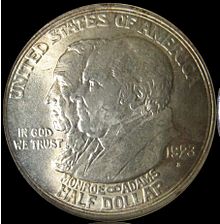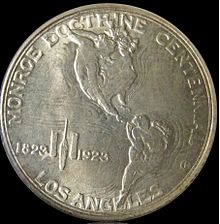United States | |
| Value | 50 cents (0.50 USD) |
|---|---|
| Mass | 12.5 g |
| Diameter | 30.61 mm (1.20 in) |
| Thickness | 2.15 mm (0.08 in) |
| Edge | Reeded |
| Composition |
|
| Silver | 0.36169 troy oz |
| Years of minting | 1923 |
| Mint marks | S (all coins). Located under date on obverse. |
| Obverse | |
 | |
| Design | Conjoined heads of former presidents James Monroe and John Quincy Adams |
| Designer | Chester Beach |
| Design date | 1923 |
| Reverse | |
 | |
| Design | Stylized figures representing North and South America touch at the Panama Canal. |
| Designer | Chester Beach; resembling a design by Raphael Beck |
| Design date | 1923 |
The Monroe Doctrine Centennial half dollar was a fifty-cent piece struck by the United States Bureau of the Mint. Bearing portraits of former U.S. Presidents James Monroe and John Quincy Adams, the coin was issued in commemoration of the centennial of the Monroe Doctrine and was produced at the San Francisco Mint in 1923. Sculptor Chester Beach is credited with the design, although the reverse closely resembles an earlier work by Raphael Beck.
In 1922, the motion picture industry was faced with a number of scandals, including manslaughter charges against star Roscoe "Fatty" Arbuckle. Although Arbuckle was eventually acquitted, motion picture executives sought ways of getting good publicity for Hollywood. One means was an exposition, to be held in Los Angeles in mid-1923. To induce Congress to issue a commemorative coin as a fundraiser for the fair, organizers associated the exposition with the 100th anniversary of the Monroe Doctrine, and legislation for a commemorative half dollar for the centennial was passed.
The exposition was a financial failure. The coins did not sell well, and the bulk of the mintage of over 270,000 was released into circulation. Beach faced accusations of plagiarism because of the similarity of the reverse design to a work by Beck, though he and fellow sculptor James Earle Fraser denied any impropriety. Many of the pieces that had been sold at a premium and saved were spent during the Depression; most surviving coins show evidence of wear.